1988 Audi V8 Typ 4C
Dr Ferdinand Piech saw the Audi V8 as the next rung on the ladder to world dominance. But is it good enough to impress Will Beaumont on a typically wet day in Wales?
WORDS: WILL BEAUMONT
PHOTOS: DEAN SMITH
While I appreciate this carries very little weight as I am no industry heavy hitter, I think one of the biggest mistakes in the motoring world is that Audi didn't serialise the Quattro. Imagine if the four-wheel drive icon had evolved, staying loyal to its original concept, as if it had been Audi's 911. I'd love to see a modern-day Audi coupe with a longitudinal turbocharged five-cylinder planked way ahead of the front axle and mated to a symmetrical four-wheel drive system. Add a short-wheelbase version into the Quattro line-up as the GT3-style special model, perfect.
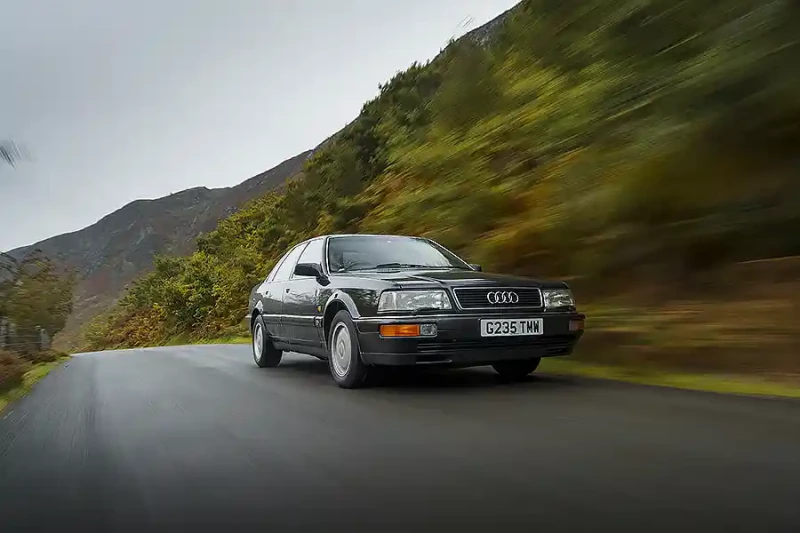
For those of us, like me, whose hymns are those of five-cylinder warbles and turbo whistles, and pray to the mother, son and the holy ghost Michele Mouton, Walter Rohrl and Hannu Mikkola, Audi's Quattro arrangement is more than just four-wheel drive.
Declaring the lack of a true Quattro successor a huge mistake squarely criticises one of the car industry's most respected characters, for it was Dr Ferdinand Piech who was at Audi's helm when the revolutionary Quattro was taken off sale. But he was also partly responsible for the existence of the Quattro in the first place. As the grandson of Ferdinand Porsche, Piech started his career at Porsche and oversaw projects like the 909 Bergspyder and Le Mans-winning 917. He made the move to Audi in 1975 to become head of research and development and pioneered the idea of a four-wheel drive performance car. After some elaborate stunts, he convinced the Audi and VW management to put the Quattro into production. He went on to become head of the Volkswagen Group, turning it into the massive multinational car company it is today. Piech sadly died in 2019 after retiring in 2015.
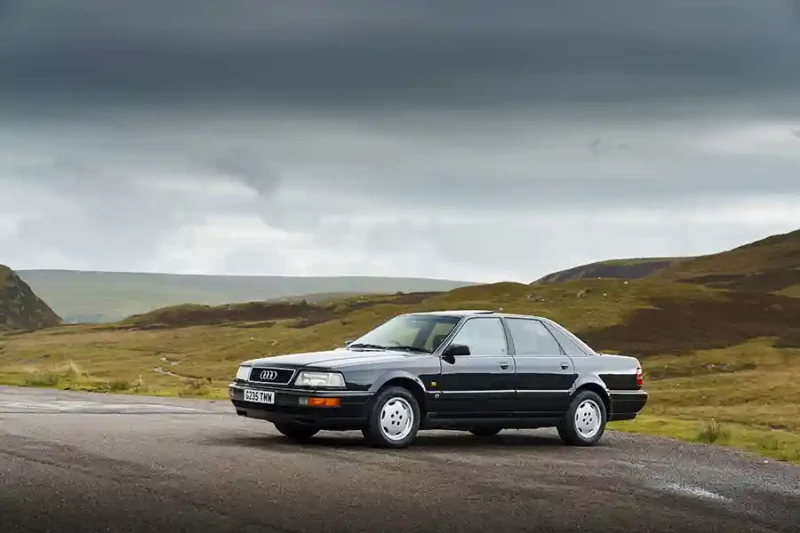
I am in no position to question the decisions of someone so obviously successful. I know that, but Piech and Audi's history are swirling around my mind because I am sitting here mulling over an Audi that is, depending on your outlook, the car that killed Quattro, the template for modern Aud is or one of the doctor's mistakes. That car is the Audi V8.
It's difficult to call Audi's first foray into the luxury saloon market a success. It was launched in 1988, the very same year Piech was made CEO of Audi. It cost 50 million Deutschmarks to develop and was only on sale for six years. In that time over 21,000 were built. Its late '80s rivals from BMW and Mercedes-Benz not only survived for longer but were sold in far greater numbers. The W126 Mercedes-Benz S Class, for instance, was on sale for 12 years and over 800,000 were built.
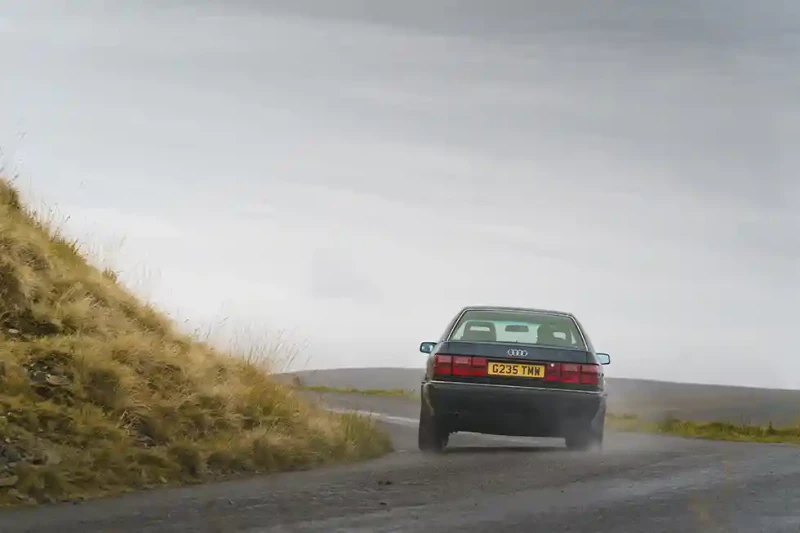
Plain figures don't tell the story of what an engineering marvel the V8 was when it became Audi's flagship. Neither do the car's looks. Visually, the V8 looks remarkably similar to the C3-generation 100 and 200 that had been launched six years before. That's because the V8 used the same monocoque as the 100 and 200 but with a 12mm longer wheelbase. All three cars were built in Neckarsulm, Germany, but wider arches (to cover a wider track), different bumpers, grille and rear lights were the only subtle differences between the V8 and the less luxurious saloons in Audi's line-up. Apparently, only the door skins are shared between the V8 and the C3s, but it looks like more.
Such an under-the-radar attitude is what is blamed for the V8's lack of success. Perhaps its looks took the brunt of the criticism because it's difficult to find a better reason as to why very few people chose the Audi, it was such an advanced car. Its equipment levels were astounding.
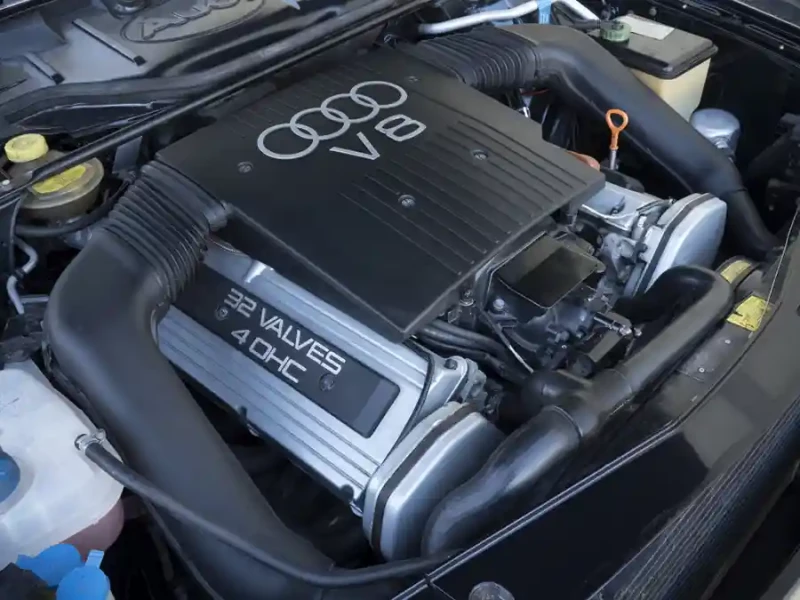
Both the comfort and sport seat options were heated, electrically operated and with a memory function. European versions got a phone, it had an on board computer to display range and fuel consumption, it was fitted with climate control and a six-speaker radio cassette with rear headphone sockets. Seventeen million Deutschmarks of the car's development funding was ploughed into a new acoustic wind tunnel at Audi's Neckarsulm plant so that it could be as refined as possible. This investment resulted in a drag coefficient of 0.32, a little more than the revolutionary and significantly skinnier 100.
It was advanced to its core, too. Its body was fully galvanised to prevent rust and came with a 10-year body warranty. It was fitted with Audi's Procon Ten safety system that pulled the steering wheel into the dash in the event of a head-on collision. Cables connect the steering column to the gearbox so that when the drivetrain is pushed back in a collision, the steering wheel is pulled forward. To make it extra safe, the V8 was also fitted with an airbag.
The extra weight and added performance of the V8 over the 100 and 200 demanded better braking force. But comfort and refinement, let alone a lack of tyre choice, restricted Audi from fitting wheels larger than 15 inches in diameter. Not deterred by this hurdle, along with ATE, Audi designed a set of disc brakes where the caliper was mounted on the inside by the hub. The V8's front brake discs are just a ring, like a flat Polo mint with nothing on the inside. Their outside edge is then attached to a bell that looks like a steel wheel but without a rim. The bell and disc are bolted to the hub and the caliper — a single piston sliding set-up — is mounted with its jaws facing outward and clamping the disc from the inside. This allowed Audi to fit 310mm brake discs because the further out the greater the leverage and the better the braking force.
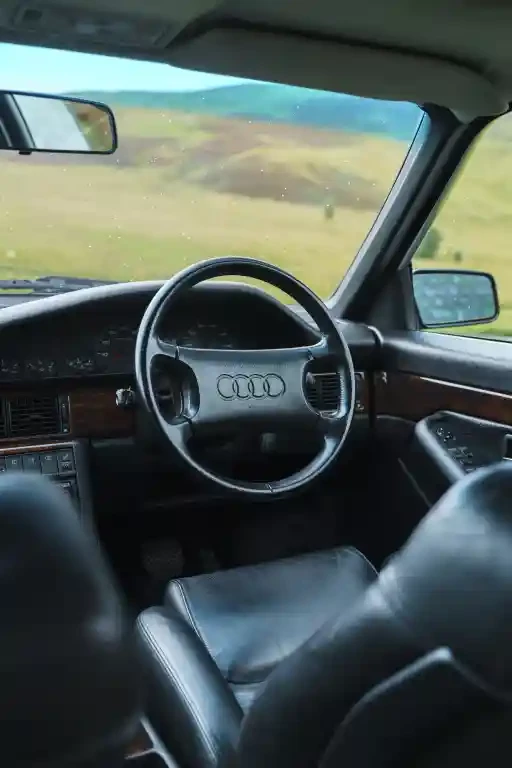
Initially, the V8 was going to be called the 300 but its eight-cylinder motor was such a triumph that it deserved to take the limelight — the V8 name also helped to further differentiate it from its C3 brethren. Wags complained that the new V8 was just two 1.8-litre Golf GTI 16-valve four-cylinder engines thrust together. When you consider the 3.6-litre capacity of the V8 you can see where they might have got this idea. And there's some truth to it, too. Sensibly, after designing ideal valve angles, port lengths and valvetrain drive for its new twin-cam four-valve head GTI motor, the VW Group applied that learning to its new V8. Like the GTI engine, the Audi 3.6 V8 uses a timing belt to drive just the exhaust camshafts. The inlet cam is then driven by a chain that connects both camshafts. In the V8, this chain is at the front of the engine on one bank of cylinders and at the back on the other. This helped reduce the engine's length and made the 3.6-litre unit the shortest V8 on the market. Unlike the GTl's engine, the V8's block was made of aluminium.
Two of the patents Audi was granted for the V8 are related to its engine: its induction system and a honeycomb sump. The final one was noise-reducing insulation so its masterpiece was barely audible. The 3.6-litre V8 produced 247bhp at 5800rpm and 251 lb ft of torque at 4000rpm. Enough to propel the big saloon to 62mph in 5.2 seconds. Even better, from 1992, Audi offered a 4.2-litre version with 276bhp and 295Ib ft which shaved 0.4 seconds from the acceleration time. The only other development of the V8 was in 1989 when a long-wheelbase version was made available. Engineered and built by Steyr-Daimler-Puch, the V8L had its 320mm extra length added behind the rear doors. Its key features were electronic rear seats, a whole 50% more expensive, and most remarkably, a fax and answering machine.
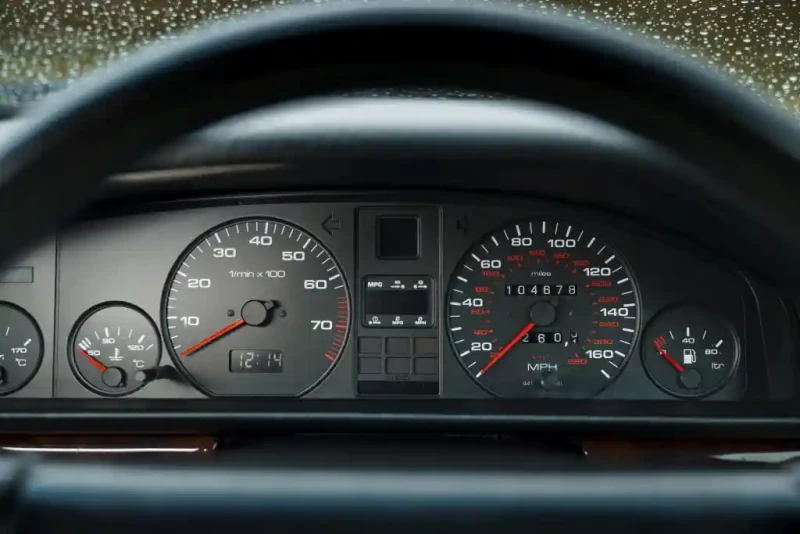
Naturally, because this is an Audi, and why it's quite so remarkably fast off the line, the V8 has four-wheel drive. Behind its short engine is a differential for the front axle, then there's the gearbox followed by two Torsen LSDs — one for the centre and one for the rear diff. The 3.6 V8 was equipped with a five-speed manual and the 4.2 version with a six-speed. The V8 was also available with a four-speed automatic, too. To properly compete with the 7 Series E32 and S-Class W126 it simply had to have an auto. But this transmission did impact the acceleration of the car. The 3.6 is 1.3 seconds slower to 62mph and the 4.2 takes 0.8 seconds longer.
The V8 was the first time Audi had combined an automatic gearbox with four-wheel drive. I am loathe to say that it was the first time Audi combined an auto with its quattro system. You see, for those of us, like me, whose hymns are those of five-cylinder warbles and turbo whistles, and pray to the mother, son and the holy ghost: Michele Mouton, Walter Rohrl and Hannu Mikkola, Audi's quattro arrangement is more than just four-wheel drive.
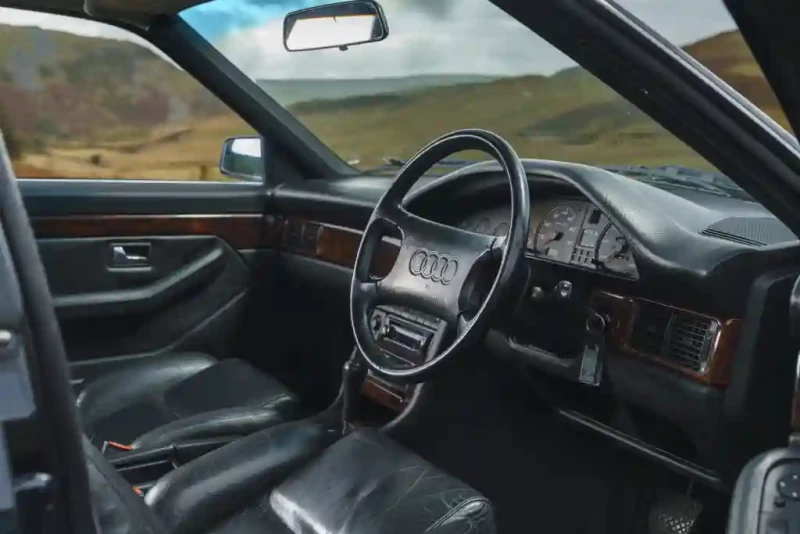
Quattro was an all-new four-wheel drive system. In the 1970s Audi knew the benefits of all-wheel drive, but the bulky set-up that Jensen had used on theInterceptor FF, with its offset front diff, was too similar to that of off-road car setups and didn't suit the high-tech persona Audi was trying to establish. Subaru's four-wheel drive might have had the advantage of being symmetrical, but without a centre differential it was too crude for use in an Audi. Under Piech's leadership, Audi's head of pre-development Walter Treser and engineers Jorg Bensinger and Roland Gumpert developed the quattro system. They took Audi's transaxle case, with the front diff in the gearbox's bell housing, and attached a centre differential to the back of it. Like a rear-wheel drive car, a propshaft connected the back of the transmission to a rear differential. The clever bit was how the team sent drive forwards. They made the gearbox's countershaft hollow and connected the front and centre diffs through the space inside. This solution ticked all of Audi's boxes. It was light, symmetrical, refined and cutting edge.
The problem with a proper automatic gearbox is that there is no countershaft to make hollow. So instead of a proper quattro system, as pioneered on the Quattro coupe, the automatic V8 was equipped with something of a compromised four-wheel drive system. The front differential is offset to the right of the transmission and is driven by a shaft that runs down the outside of the gearbox. However, there's one upside to the auto V8's setup, instead of a Torsen centre diff it has a very modern hydraulically controlled multi-plate clutch in the middle that can send up to 80% of the torque to the front or back.
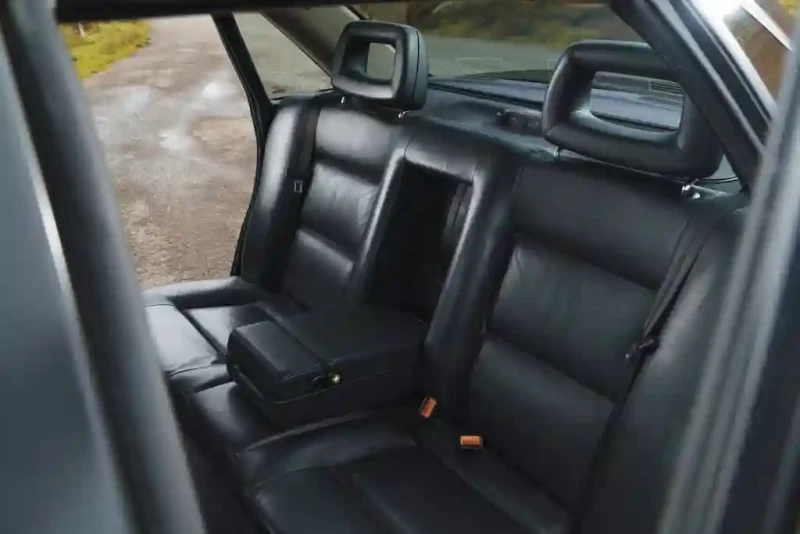
Great, but just as I don't consider an on-demand Haldex unit a quattro system, neither is the auto in the V8. Shockingly, these days you cannot buy a proper quattro Audi. They might have quattro badges all over them, but not one car in the current Audi line-up has a permanent and symmetrical four-wheel drive system. Not even the cars with dual-clutch gearboxes, a system that utilises the hollow shaft technology that the original quattro transaxle pioneered. So, while the V8 might have been the first to corrupt the quattro name, this bastardised non-symmetrical system has won out. Welcome to the first modern Audi.
There must be a reason why the V8's template prevailed. And I am jumping straight in at the deep end with this car to find out why. While lounging in my library, contemplating my stocks, smoking a cigar and listening to Bach — getting into the spirit of being an Audi V8 driver and definitely not sanding Polyfilla off a ceiling like a man too cheap to pay a decorator — the plans for the car's shoot were taking place without my input. It was decided that mid-Wales was the spot, and I'd meet Dean, the trusty snapper, that evening near the Elan Valley. A last-minute decision to drive three and a half hours is often something to dread. But I don't have some flimsy sports car to ferry me across the border or a raucous track special, I have a luxury limo. A stint on the outside lane of the motorway then a blast down the fast A-roads of east Wales is exactly the sort of journey the V8 was designed for, so I'm actually quite grateful this decision has been made for me.
It's an odd time to start a big journey, as the sun is starting to set. This means I am going to be sitting in the V8's sporty-looking chairs as the clock ticks past my normal bedtime. The V8, here an early 3.6, starts with the gentlest of rumbles. Quiet, yet tough. Comforting in a secure way. The exact feeling you try to create to send a child off to sleep. The seats, while they look two sizes too small, as if people in 1988 were a different scale, don't reach up my back enough to cradle my shoulders. Yet still, they're a pleasant place to sit. There is such a thing as being too comfortable for a long journey and the V8, despite its age, might just be creating such an environment. At least the dials are clear, fuss-free and won't be adding any extra strain to my concentration.
I meander out of my village towards the motorway, feeling my way into the car steadily. It's not before I am powering down the slip road onto the motorway when spots of rain appear on my windscreen. Ordinarily this would be another thing to worry about, another distraction to sap away at my brain's resources. But I'm in an Audi, proper quattro or not, this car still has four-wheel drive. It's designed to master snowy roads without the need for traction control, or so Audi said at the time. A bit of rain shouldn't be a problem.
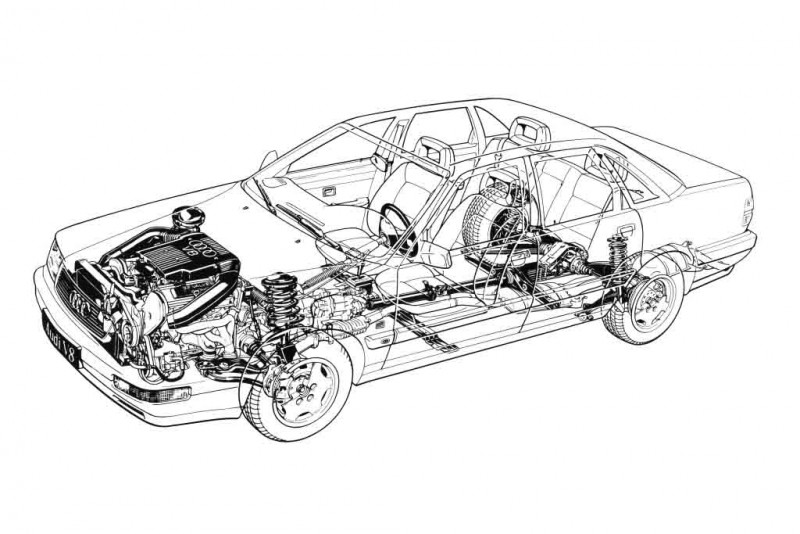
When interviewed about the V8, Piech said that 200 to 220kmh was its ideal cruising speed. Between 120 and 140mph. Well, that might be the case on the Autobahn, but on the M6 an indicated 70mph feels just fabulous. I prod and poke the cruise control buttons to try to make them take over so I can relieve my feet. The instructions on the stalk are in German, and with my limited language skills I can't work out the difference between FIX and AUFN.
After a sequence of button presses that I can't remember, I unlock the special move and the engine rumbles away without input from my right foot. I hope I don't have to try to pause and resume the cruise control too often. Thankfully, despite this being a somewhat subtle Audi, especially by modern standards, it exhibits what the Germans call 'eingebaute Vorfahrt', built-in right-of-way. It has the necessary presence of a big Autobahn-dwelling saloon and slower-moving traffic is keen to move left when they see the V8 in their mirrors. The rain gets worse and streams of water cross the motorway. Yet there's no need to fiddle with the cruise to drop the speed. Every time I hit a patch of standing water, the V8 stays arrow straight. I feel the pools of water try to slow the car's forward thrust, I hear the water churning in the arches. I tense ready to react, but I don't need to, it stays resolutely stable. A couple of hours of this will be a doddle.
The motorway turns to dual carriageways as the last stint of my journey approaches, flowing A-roads. It might be a Sunday night, but the roads are clogged with trucks. Or that's how it seems as they chug slowly up hills. I don't want to lumber my way to my hotel at 40mph, not only do I want a good night's rest, it seems so wrong to make the V8 dawdle at this speed. I flick the gearbox's SEM dial to Sport in preparation for the next well-sighted straight. The road opens up and I plunge the throttle pedal down and into the carpet. The cogs shuffle and the engine emits a deep, big-chested growl. It's smooth and powerful, but far from intimidating, as its power is to protect. Momentum begins to build. The acceleration is not sudden or severe, but it's determined and I sail past the truck.
I've left the rain in England but the Welsh tarmac is still wet. Nothing, however, is stopping me from keeping the Audi bang on the speed limit. The V8 arcs around the long corners elegantly and cleanly. There's no need to shed any of my momentum and I eventually crawl into my town for the night ahead of schedule.
I'm ready for bed, but I'm not walking like a zombie. Nor am I amped up on adrenaline, despite the brisk drive. It might not possess the comfort gimmicks that modern cars have, like cruise control that you can actually operate. What the V8 has, at its core, as if it was instilled in the galvanising process, is the unerring ability to keep its driver comfortable and aware over long distances.
Tomorrow's challenge is somewhat different. The roads that will climb to the pretty-looking reservoirs and beauty spots will be tight and twisty. Far from what this car was designed for. But it won't matter if it's out of its depth, it's already proven that it's achieved prime luxury car status.
It's the nature of a shoot that you watch sunsets and sunrises through the windscreen of the subject car. I say sunrise, but today it's more of a gradual brightening of grey. The very '80s blue top-band-tint of the screen keeps conning me that there's a blue sky above me, but the raindrops on the windows tell the truth, it's relentlessly grey. It's time for some heated seats. There are a whole six temperature settings to choose from, I can't help but wonder how sensitive Piech's derriere was. While the Doctor saw the V8 as the fourth step to Audi's dominance — the first three were quattro all-wheel drive, aerodynamic shapes and fully galvanised chassis — he absolutely developed this car for himself and his family. Piech's old V8 resides on the top floor of the Klassikstadt in Frankfurt and a one-off Avant was built for his wife Ursula.
Bum warmed to a three, I venture further from the town, into the hillside proper and the roads shrink. Not just width ways, but as if they've been compressed. The corners are frequent and tight, the crests and dips severe and endless. It's a quintessential tarmac rally stage. You can almost hear the distant burble of a five-cylinder motor and the bangs of anti-lag in the distance. This is quattro territory.
And I keep getting a glimpse of the V8's quattro script in my rear-view mirror. The letters make up part of the heated window element, the logo is embedded within the car as if to convince naysayers like me that it's a proper quattro. Seeing the quattro logo behind me and this road ahead seems so appropriate, but something is missing.
There's simply not enough feedback from the V8's chassis or controls for me to pretend I am on a RAC Special Stage. It would take someone with a truly vivid imagination to see through the V8's comfy setup and envision a competition car. But someone did and Audi campaigned a Group A-spec V8 in DTM. Hans-Joachim Stuck won the 1991 championship in a V8, the car's inaugural year, and the year after Frank Biela took the top spot in the Audi. Audi didn't compete in 1993, its new flat-plane crank was deemed illegal — the road car uses a more common cross-plane crank — but that meant the V8 maintained its perfect score.
It's baffling to think of this as a championship racer as I use every sense to try and penetrate through the layers of luxury to get the faintest insight of the grip that's available. The chassis is delightfully unflustered, yes, but it's unintelligible. The steering is cryptic, too, but it has a saving grace: it's fast. So sharp that even the tightest corners don't tempt me to move my hands from a quarter-to-three position. As the road winds and dives and I jink the steering from left to right, I develop a rhythm. And even though I can't sense the car's hold on the tarmac, it never falters as I increase the pace.
It's the gearbox that eventually encourages me to let go of the wheel and reach for the central dial. Not Sport this time, but Manual. You can notch the selector forward and back to change gear. Use the lever in Comfort and Sport and you only limit the highest gear the box will use. In Manual, it stays in the gear you choose. The changes aren't any faster in Manual mode, but there's no need to wait for the kickdown and the 'box to catch up with your expectations.
Still, even with this control, it's the gearbox that's the limiting factor of the V8's speed on such tortuous roads. You simply cannot make the most of the V8's 00mph, because on a road like this everything happens much more rapidly than the auto 'box can cope with. What this does mean is that you never approach the limits of the car. Not even in the wet does the momentum get so great that the fast steering can make the quattro system second-guess itself. The V8 stays committed to whatever you do with its fast steering. It is planted. You might not feel keyed into every quiver and squirm of the tyres' tread blocks, but the entire car creates a deep sense of confidence. It is impressive. It feels like an Audi.
I cannot, with all honesty, sense any downside to the V8's four-wheel drive system. It displays all the same attributes that make the Quattro coupe so impressive. Ample all-weather grip, total refinement and complete reassuring security at every wheel. I'll always admire the original quattro technology, but I'd be lying if I said hollow-shaft-quattro tech was noticeably better than the V8's setup. What I can say is that this offset front diff is certainly better than 1980s automatic gearbox technology.
As the sun sets on my second day behind the wheel of the V8, the rally stage-like roads behind me, thoughts of chirping and banging turbocharged rally cars melt away totally. The unsuccessful task of finding flaws in a four-wheel drive system I am less impressed by is no longer a priority. I forget all my principles completely, for I am deeply grateful to embark on my wet and dark border-crossing dash back home in an Audi V8.


